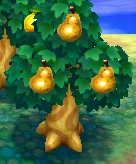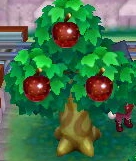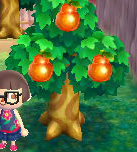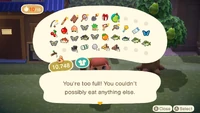| Fruit • | Gallery |
Fruit are common items that grow from fruit trees and palm trees in all Animal Crossing series titles. They can be eaten and are sometimes requested by villagers.
Each town starts with one of five types of fruit as its native fruit: Apples, Oranges, Cherries, Pears, or Peaches. There is a 20% chance for the town to have any given native fruit. Native fruits sell for 100 Bells, but non-native fruits sell for 500. Up until New Leaf, coconuts also sold for 500 bells, as they weren't native to any town, but sell for 250 bells in New Leaf and New Horizons.
In New Leaf, new fruits have been added to the series for the first time since Animal Forest+: Lychees, Durians, Lemons, Bananas, Mangoes, and Persimmons. Some of these types of fruit are considered tropical fruit, each of which are available from Tortimer Island or from T&T Emporium, selling for 250 Bells each. In addition, coconuts have had their price fixed at 250 bells since they are now an Island fruit. Another addition is the ability to have ten items of the same fruit to be stacked, saving space in the inventory.
Pocket Camp introduced Grapes to the series.
List of Fruit[]
| Fruit | Image | Grows on | AF | AF+ | AC | AFe+ | WW | CF | NL | PC | NH | Sell price |
|---|---|---|---|---|---|---|---|---|---|---|---|---|
| Apple | Fruit tree | ✓ | ✓ | ✓ | ✓ | ✓ | ✓ | ✓ | ✓ | ✓ | 100/500
10 (PC) | |
| Orange | Fruit tree | ✓ | ✓ | ✓ | ✓ | ✓ | ✓ | ✓ | ✓ | ✓ | 100/500
10 (PC) | |
| Cherry | Fruit tree | ✓ | ✓ | ✓ | ✓ | ✓ | ✓ | ✓ | ✓ | ✓ | 100/500
10 (PC) | |
| Pear | Fruit tree | ✓ | ✓ | ✓ | ✓ | ✓ | ✓ | ✓ | ✓ | ✓ | 100/500
10 (PC) | |
| Peach | Fruit tree | ✓ | ✓ | ✓ | ✓ | ✓ | ✓ | ✓ | ✓ | ✓ | 100/500
10 (PC) | |
| Coconut | Palm tree | ✓ | ✓ | ✓ | ✓ | ✓ | ✓ | ✓ | ✓ | ✓ | 250
10 (PC) | |
| Banana | Palm tree | ✓ | 250 | |||||||||
| Durian | Fruit tree | ✓ | 250 | |||||||||
| Lemon | Fruit tree | ✓ | ✓ | 250
10/600 (PC) | ||||||||
| Lychee | Fruit tree | ✓ | ✓ | 250
10/600 (PC) | ||||||||
| Mango | Fruit tree | ✓ | 250 | |||||||||
| Persimmon | Fruit tree | ✓ | 250 | |||||||||
| Grapes | Fruit tree | ✓ | 10/600 |
Obtaining Fruit[]

Cherries in Gekijōban Dōbutsu no Mori.
Throughout the games, there are many ways the player can obtain different fruit. One consistent method throughout the Animal Crossing series is that fruit can be obtained as a gift from Mom or from villagers. Sending a villager a one-line letter with a piece of fruit can initiate a random fruit being sent in return.
- Main article: Trees
Fruit can be shaken out of their own trees that bear three pieces of fruit every three days. Coconut and banana trees must be planted on the beach and all trees must grow with one tree's span between them.
Animal Crossing, Wild World, and City Folk[]
Coconuts are found in various ways. In GCN games, they are obtained from the Island. In Wild World and City Folk, they randomly wash up on the beach.
New Leaf[]
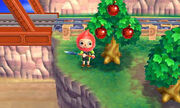
Player standing next to a perfect apple tree
All fruits can be obtained from Tortimer Island either through the island itself or on an Island Tour. (Except for the Labyrinth Tour, where you can only collect one specified fruit that you can’t keep.)
In New Leaf, Isabelle will eventually give the player three pieces of a second, non-native fruit when her tutorial has been completed. This fruit is always one of the five starting fruits. The non-native fruit given by her depends on the native fruit of the town. For instance, a town whose native fruit is cherries will receive apples as Isabelle's gift.
In New Leaf, the player may get non-native fruits during the Harvest Festival when catching a fish that a villager requested. It is also possible to get any kind of fruit by doing favors for villagers.
Any of the five starting fruit types can be requested by villagers, provided that fruit type is available in town.
Persimmons can be purchased from T&T Emporium for 1,000 Bells.
Pocket Camp[]
In Pocket Camp, all five possible native fruits grow on trees in Breezy Hollow and two of them grow in Lost Lure Creek, with coconuts growing in Saltwater Shores and Sunburst Island. Additionally, either lemons, lychee, or grapes grow on trees in both Breezy Hollow and Lost Lure Creek, but only one of the three is native. In order to get the other two, you have to buy them from other players at their Market Box. Fruit takes three hours to grow back when shaken down and can grow back instantly if the player uses fertilizer.
New Horizons[]
In New Horizons, one type of non-native fruit can be obtained by using a Nook Miles Ticket and going on a Mystery tour. This is a guaranteed method of finding coconuts.
Perfect Fruit[]
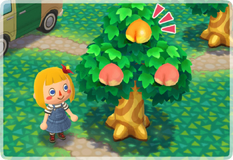
Perfect peach in Pocket Camp.
Perfect fruits appear in New Leaf and Pocket Camp. Any of the native fruits (apples, oranges, peaches, pears, and cherries) can be perfect, which gives them a slightly different look from their regular counterparts. In Pocket Camp, grapes, lemons and lychees can also be perfect. Pocket Camp also introduced a small chance that two perfect fruits appear on a tree.
Usually, at least one perfect native fruit appears at the start of the game. Trees can very rarely yield perfect fruit, though burying fertilizer next to the tree increases the chances of this happening. Perfect fruit sells for 600 bells if native or 3,000 bells if not native.
| Fruit | Image | Grows on | AF | AF+ | AC | AFe+ | WW | CF | NL | PC | NH | Sell price |
|---|---|---|---|---|---|---|---|---|---|---|---|---|
| Perfect Apple | Fruit tree | ✓ | ✓ | 600/3000 | ||||||||
| Perfect Orange | Fruit tree | ✓ | ✓ | 600/3000 | ||||||||
| Perfect Cherry | Fruit tree | ✓ | ✓ | 600/3000 | ||||||||
| Perfect Pear | Fruit tree | ✓ | ✓ | 600/3000 | ||||||||
| Perfect Peach | Fruit tree | ✓ | ✓ | 600/3000 | ||||||||
| Perfect Grapes | Fruit tree | ✓ | 600/3000 | |||||||||
| Perfect Lemon | Fruit tree | ✓ | 600/3000 | |||||||||
| Perfect Lychee | Fruit tree | ✓ | 600/3000 |
Perfect fruit trees[]
Perfect trees yield three perfect fruits up to seven times. It can only be grown in a town where it is the native fruit by burying a perfect fruit. If the player tries to plant a perfect non-native fruit tree, it produces only regular fruit.
On the last shake, perfect fruit trees lose their leaves and do not regrow or bear any further fruit unless replanted. Additionally, on the final batch, one of the perfect fruits will be rotten. The dead tree can be cut down to be replaced. Burying fertilizer next to a dead perfect tree causes it to regrow the next day. Rotten fruits have a disposal fee of 500 bells if they are native or 3,000 Bells if not native, and if one is planted, it creates a dead sapling. However, they can be fed to a villager wanting fruit of any kind, though it shall disgust one. If a player leaves a rotten fruit on the ground, ants will regularly come onto it and can be caught. Rotten fruit looks the same as its healthy counterpart.
Stamina[]
In New Horizons, eating one fruit gives the player the temporary ability to shovel a fully-grown tree or break a rock. A counter appears on the upper-left screen showing how much fruit the player has eaten. The player can eat at most 10 fruit until a speech bubble appears telling the player, "You're too full! You couldn't possibly eat anything else." The number decreases by one every time the player digs up a tree or breaks a rock.
Once th8e counter reaches 0, the player can't dig up fully-grown trees or break any more rocks until they eat another fruit. The counter can also be fully depleted by saving and ending the game or by sitting on toilet furniture.
Trivia[]
- There is a glitch in Animal Crossing: New Leaf where a fruit tree holds fewer than three pieces of fruit.
- Some of the various Fruit and Perfect Fruit in the Animal Crossing series take on the appearance of specific real-world cultivars.
- Apples appear as red with a yellow bottom-half, resembling a Jonagold Apple. In New Leaf, Perfect Apples appear a deep crimson colour with white specks, resembling a Red Delicious Apple.
- Peaches appear a light pink colour, resembling white peaches, which are common in eastern countries like Japan. Perfect peaches appear yellow-orange in colour, and while not exactly accurate, they could represent the western yellow peach variety.
- Perfect Oranges have a smaller orange growing out of the top, making them resemble a pear. This is likely based off of the Tangelo, a hybrid between a tangerine and an orange, which possess a bulge near the stem. It could also be somewhat based off of navel oranges, which have a second, smaller orange growing inside of them, causing the larger orange to appear to have a belly button, hence the name.
- Perfect Cherries appear bright red with a yellow underside, resembling the yellow-fleshed Rainier Cherry.
In other languages[]
| Fruit | |||||||||||||||
|---|---|---|---|---|---|---|---|---|---|---|---|---|---|---|---|
| |||||||||||||||
| Plants | ||
|---|---|---|
| ||



